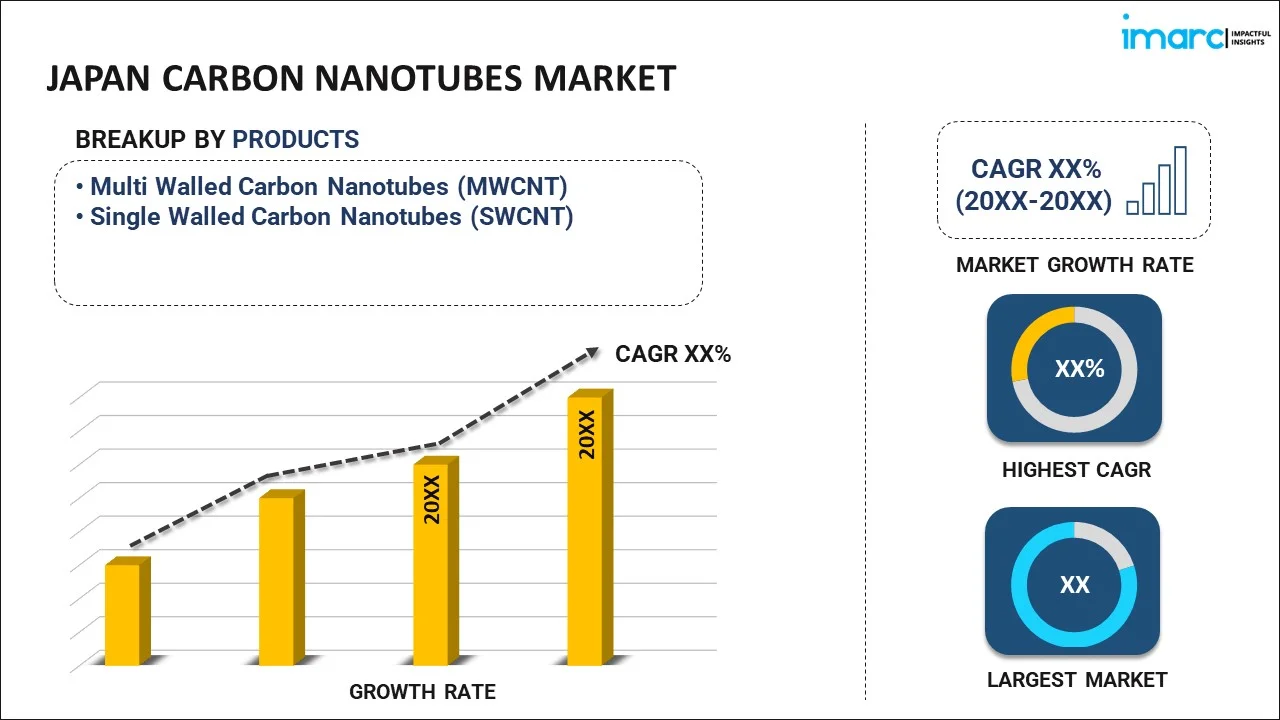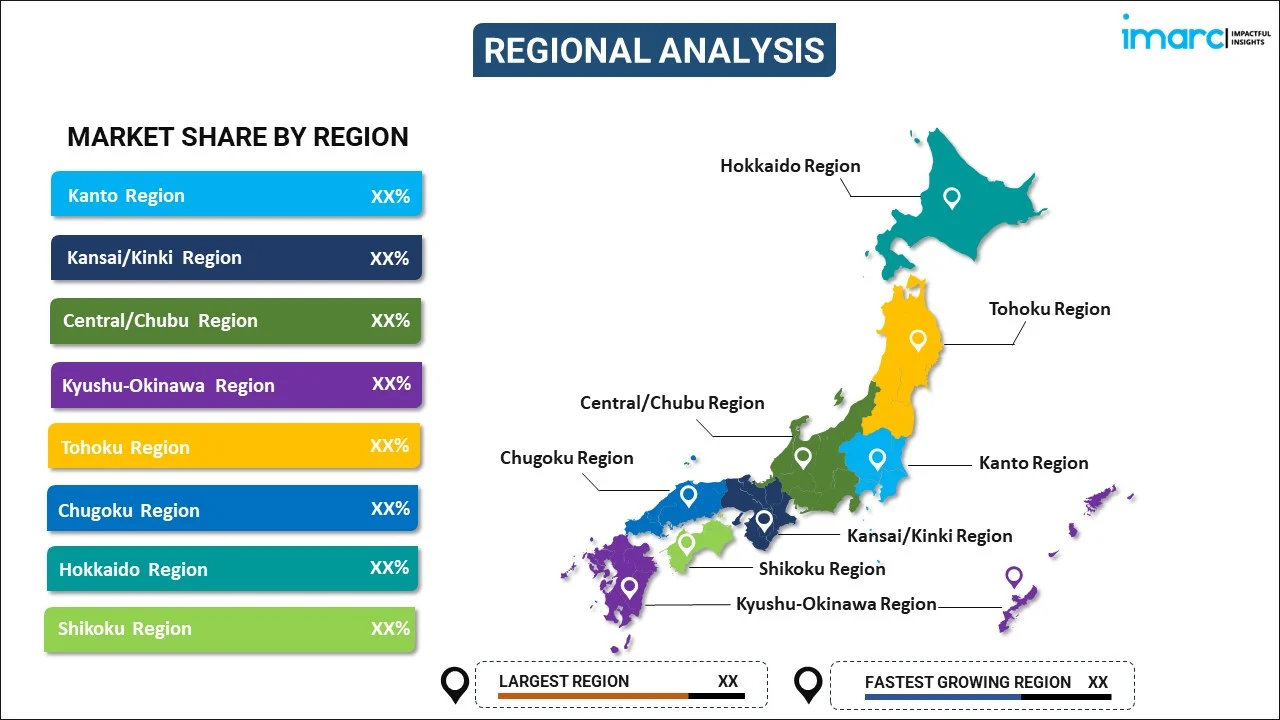
Japan Carbon Nanotubes Market Report by Product (Multi Walled Carbon Nanotubes (MWCNT), Single Walled Carbon Nanotubes (SWCNT)), Method (Chemical Vapor Deposition (CVD), Catalytic Chemical Vapor Deposition (CCVD), High-Pressure Carbon Monoxide Reaction, and Others), Application (Polymers, Electrical and Electronics, Energy, and Others), and Region 2025-2033
Market Overview:
Japan carbon nanotubes market size reached USD 390.0 Million in 2024. Looking forward, IMARC Group expects the market to reach USD 620.0 Million by 2033, exhibiting a growth rate (CAGR) of 5.3% during 2025-2033. The expanding medical and healthcare industry, which utilizes carbon nanotubes for drug delivery, imaging, and diagnostics due to their ability to carry drugs to specific locations in the body, thereby reducing side effects and improving treatment efficacy, is driving the market.
|
Report Attribute
|
Key Statistics
|
|---|---|
|
Base Year
|
2024
|
|
Forecast Years
|
2025-2033
|
|
Historical Years
|
2019-2024
|
|
Market Size in 2024
|
USD 390.0 Million |
|
Market Forecast in 2033
|
USD 620.0 Million |
| Market Growth Rate 2025-2033 | 5.3% |
Carbon nanotubes (CNTs) are cylindrical structures made of carbon atoms arranged in a hexagonal lattice, resembling rolled-up sheets of graphene. They exhibit remarkable properties due to their unique structure. CNTs can be single-walled (SWCNTs) with one layer of carbon atoms or multi-walled (MWCNTs) with several concentric layers. CNTs possess exceptional strength and stiffness, making them one of the strongest materials known. They conduct electricity efficiently and have excellent thermal conductivity. These properties make them valuable in various applications, including electronics, materials science, and nanotechnology. CNTs are used in the development of lightweight and strong materials for aerospace and automotive industries. They also show promise in medical applications, such as drug delivery and tissue engineering. Moreover, their electrical conductivity makes them suitable for nanoscale electronics, like transistors and sensors. Despite their enormous potential, challenges remain in mass production and functionalization. Ongoing research seeks to harness the full potential of CNTs while addressing these issues, opening up a world of possibilities in science and technology.
Japan Carbon Nanotubes Market Trends:
The carbon nanotubes market in Japan is experiencing substantial growth, driven by a myriad of factors. Foremost among these is the increasing demand from various end-use industries, such as electronics, automotive, aerospace, and energy, where CNTs are highly valued for their exceptional mechanical, electrical, and thermal properties. Additionally, the escalating pursuit of miniaturization in electronics has propelled the need for materials like CNTs that can contribute to smaller, lighter, and more efficient components. Furthermore, ongoing R&D activities are consistently unveiling new potentials and applications of CNTs, subsequently leading to an expansion in their market reach. In conjunction with these factors, governments and regulatory bodies in Japan are implementing policies and initiatives that encourage the adoption of advanced materials, further bolstering the market. Moreover, the automotive industry’s shift towards lightweight materials to enhance fuel efficiency has also served as a significant catalyst for the CNTs market growth. Apart from this, the rising focus on renewable energy sources, which utilize the CNTs in energy storage and conversion devices, such as batteries and supercapacitors, owing to their superior conductivity and high surface area, is expected to drive the CNTs market in Japan during the forecast period.
Japan Carbon Nanotubes Market Segmentation:
IMARC Group provides an analysis of the key trends in each segment of the market, along with forecasts at the country level for 2025-2033. Our report has categorized the market based on product, method, and application.
Product Insights:

- Multi Walled Carbon Nanotubes (MWCNT)
- Single Walled Carbon Nanotubes (SWCNT)
The report has provided a detailed breakup and analysis of the market based on the product. This includes multi walled carbon nanotubes (MWCNT) and single walled carbon nanotubes (SWCNT).
Method Insights:
- Chemical Vapor Deposition (CVD)
- Catalytic Chemical Vapor Deposition (CCVD)
- High-Pressure Carbon Monoxide Reaction
- Others
A detailed breakup and analysis of the market based on the method have also been provided in the report. This includes chemical vapor deposition (CVD), catalytic chemical vapor deposition (CCVD), high-pressure carbon monoxide reaction, and others.
Application Insights:
- Polymers
- Electrical and Electronics
- Energy
- Others
The report has provided a detailed breakup and analysis of the market based on the application. This includes polymers, electrical and electronics, energy, and others.
Regional Insights:

- Kanto Region
- Kansai/Kinki Region
- Central/ Chubu Region
- Kyushu-Okinawa Region
- Tohoku Region
- Chugoku Region
- Hokkaido Region
- Shikoku Region
The report has also provided a comprehensive analysis of all the major regional markets, which include Kanto Region, Kansai/Kinki Region, Central/ Chubu Region, Kyushu-Okinawa Region, Tohoku Region, Chugoku Region, Hokkaido Region, and Shikoku Region.
Competitive Landscape:
The market research report has also provided a comprehensive analysis of the competitive landscape in the market. Competitive analysis such as market structure, key player positioning, top winning strategies, competitive dashboard, and company evaluation quadrant has been covered in the report. Also, detailed profiles of all major companies have been provided.
Japan Carbon Nanotubes Market Report Coverage:
| Report Features | Details |
|---|---|
| Base Year of the Analysis | 2024 |
| Historical Period | 2019-2024 |
| Forecast Period | 2025-2033 |
| Units | Million USD |
| Scope of the Report | Exploration of Historical and Forecast Trends, Industry Catalysts and Challenges, Segment-Wise Historical and Predictive Market Assessment:
|
| Products Covered | Multi Walled Carbon Nanotubes (MWCNT), Single Walled Carbon Nanotubes (SWCNT) |
| Methods Covered | Chemical Vapor Deposition (CVD), Catalytic Chemical Vapor Deposition (CCVD), High-Pressure Carbon Monoxide Reaction, Others |
| Applications Covered | Polymers, Electrical and Electronics, Energy, Others |
| Regions Covered | Kanto Region, Kansai/Kinki Region, Central/ Chubu Region, Kyushu-Okinawa Region, Tohoku Region, Chugoku Region, Hokkaido Region, Shikoku Region |
| Customization Scope | 10% Free Customization |
| Post-Sale Analyst Support | 10-12 Weeks |
| Delivery Format | PDF and Excel through Email (We can also provide the editable version of the report in PPT/Word format on special request) |
Key Questions Answered in This Report:
- How has the Japan carbon nanotubes market performed so far and how will it perform in the coming years?
- What has been the impact of COVID-19 on the Japan carbon nanotubes market?
- What is the breakup of the Japan carbon nanotubes market on the basis of product?
- What is the breakup of the Japan carbon nanotubes market on the basis of method?
- What is the breakup of the Japan carbon nanotubes market on the basis of application?
- What are the various stages in the value chain of the Japan carbon nanotubes market?
- What are the key driving factors and challenges in the Japan carbon nanotubes?
- What is the structure of the Japan carbon nanotubes market and who are the key players?
- What is the degree of competition in the Japan carbon nanotubes market?
Key Benefits for Stakeholders:
- IMARC’s industry report offers a comprehensive quantitative analysis of various market segments, historical and current market trends, market forecasts, and dynamics of the Japan carbon nanotubes market from 2019-2033.
- The research report provides the latest information on the market drivers, challenges, and opportunities in the Japan carbon nanotubes market.
- Porter's five forces analysis assist stakeholders in assessing the impact of new entrants, competitive rivalry, supplier power, buyer power, and the threat of substitution. It helps stakeholders to analyze the level of competition within the Japan carbon nanotubes industry and its attractiveness.
- Competitive landscape allows stakeholders to understand their competitive environment and provides an insight into the current positions of key players in the market.
Need more help?
- Speak to our experienced analysts for insights on the current market scenarios.
- Include additional segments and countries to customize the report as per your requirement.
- Gain an unparalleled competitive advantage in your domain by understanding how to utilize the report and positively impacting your operations and revenue.
- For further assistance, please connect with our analysts.
 Inquire Before Buying
Inquire Before Buying
 Speak to an Analyst
Speak to an Analyst
 Request Brochure
Request Brochure
 Request Customization
Request Customization




.webp)




.webp)












